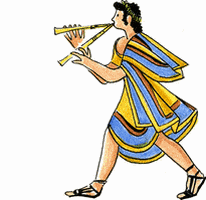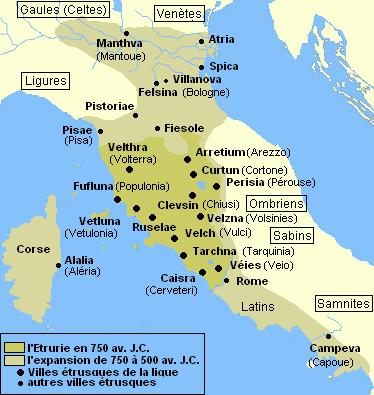Maps of the Antique
Mediterranean Sea
 The Etruscans The Etruscans
 Overview Overview
 Some dates Some dates
 Archaeological sites Archaeological sites
 Museums Museums
 Etruscan Art Etruscan Art
 Coinage Coinage
 Language and Writing Language and Writing

|
THE ETRUSCANS

|
Origins
The Romans called them “Etrusci”, the Greeks “Tyrrhenoi” (Tyrrhenian), they called themselves “Rasenna”, and their origins have been discussed since Antiquity, also considering the fact that their language remained very mysterious. Herodotus estimated that they were Lydians who had fled from famine and took on the name of Tyrrhenians, named after Tyrrhenos, son of the Lydian king. Recent finds seem to justify this theory. In any case, one can estimate that this Etruscan civilization was born from the meeting between the native Villanovan culture and the newcomers, initially perhaps Lydians, then Greeks.
The Proto-Villanovan and Villanovan culture (named after the site of Villanova, near Bologna) developed from the 12th century B.C., passing from Neolithic to metalworking age, in particular ironworking. |
Its necropoles delivered various usual objects and some ceramics. Its extent covered the approximate area of the future Etruria.
From the 8th century on, it had many contacts with the Greek world. Etruscan art conveys an image of a peaceful people cultivating happiness, but in truth, its power relied on a powerful army, designed after the Greek model.
The Greek model
By the 7th century B.C., this influence developed via Greek merchants and colonies settling in Magna-Graecia. The Etruscans then produced cereals and wine, but also fine objects. A dynamic naval construction promoted the trade. Their mines produced silver and lead, copper, tin and iron (on the isle of Elba in particular).
As in Greece, the cities multiplied, then gathered. A “dodecapolis”, a federation of twelve cities was conceived. The exact list of its members is unknown, but one may consider the names of Caera, Volterra, Volsinies (Orvieto), Tarquinia, Veii, Vulci, Clusium (Chiusi), Rusellae (Rosella), Vetulonia, Populonia, Cortone, Perugia, perhaps Arretium (Arezzo) and Fiesole.
The cities were ruled by two magistrates who ruled together - Rome would also adopt this model - but remained very independent: the unit appeared mainly in religious ceremonies.
The expansion
At the beginning of the 6th century B.C., the Etruscans, having copied the weapons and the organization of the Greek hoplites, extended their domination towards the North, around Felsina (Bologna). A “padovan dodecapolis“ was (symbolically) added to the Tuscan dodecapolis, with cities like Spina, Mantova, Modena, Parma and Melpom (Milano). In the same way, in the south, in Campania, the Etruscans create a third dodecapolis around Campeva (Capua) founded around 600 B.C., including Nola, Nocera, Herculanum, Pompei, Calatia, Sorrento, Marcina and perhaps Stabies and Suessula.
At this time, Latium was included in the Etruscan territory. It is quite possible that Rome was founded by Etruscans, towards 800 B.C. In any case, according to tradition, Rome was ruled by the Etruscan dynasty of Tarquins from 615 to 509 B.C..
From change to decline
While Etruria seemed perfectly integrated between the Mediterranean world and Alpine and Celtic Europe, some marked changes started to appear. At sea, in 535 B.C., at the battle of Alalia, an alliance between Caere and the Carthaginians drove out the Phoceans from Corsica. However Cumae resisted and the Greeks defended the Lipari islands successfully. However, the situation was soon reversed: the allied forces were then defeated by the Syracusian Greeks at Himera in 480, off Cumae in 474, then at Elba in 453. The Etruscans lost their maritime supremacy. In 414, they still helped the Athenians who besieged Syracuse, during the disastrous “expedition in Sicily”, which accelerated their fall.
On land, the Etruscans were confronted by conflicts against the Sabines and Samnites. Tarquinia and Chiusi disputed over Rome, but the Romans released themselves around 475. The Syracusans rebuilt Naples in 470 B.C. and devastated the Tuscan coasts in 453 and 384. Capua became Samnite around 421, and Campania was thus lost.
The cities of the plain of the Po would for a time maintain their influence. Adria and Spina traded with Athens and the northern cities (Felsina, Chiusi, Cortone, Perugia, Arezzo, Volsinies, Fiesole, Volterra) still flourished. However, the defeat of Athens in the expedition of Sicily and then in the Peloponnesian War profoundly affected commercial exchanges from 411 B.C. onwards.
At the same time, the Etruscans were trapped between Roman ambitions to the south and the Celtic pressure in the north. Gallic tribes cohabited for a long time with the Etruscans, but they became increasingly more numerous, and did not adopt any local customs. Mantova fell in 400 B.C., Melpom became Milano (about 396) and Felsina became Bologna (about 350).
Roman conquest
Rome, having rid itself of any foreign influence, conquered and destroyed Veii in 396 B.C. while gaining the allegiance of Caere. Rome supported without heavy consequences the Celtic raids of 390 B.C., and extended its territory at the expense of the Latins, Samnites and Etruscans, who tried to consolidate their defences but were defeated in 351 after a seven year war.
In 294 B.C., the Romans imposed their rule on Arezzo, then on Roselle in 293, Volsinia (Orvieto) in 264. Rome dominated Etruria in 265 B.C. Etruria was then merged definitively into the Roman mould after the war of the Allied nations (88 B.C.). In the 2nd century, some Roman consuls would come from Etruscan families.
|
|

















